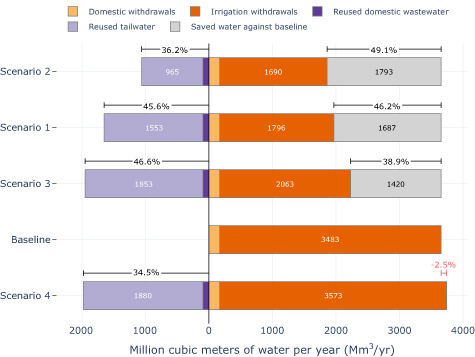Publication // Reusing wastewater for agricultural irrigation: a water-energy-food Nexus assessment in the North Western Sahara Aquifer System
By C Ramirez, Y Almulla and F Fuso Nerini. Wastewater reclaim, treatment and reuse, has a great potential to alleviate water stress in the North Western Sahara Aquifer System (NWSAS), while supporting sustainable food production and energy efficiency. In their study the authors, supported by a GIS-based quantitative analysis, use a Nexus approach to shed light on synergies and trade-offs among selected Sustainable Development targets of interest.

© C Ramirez, Y Almulla and F Fuso Nerini.
Abstract
The North Western Sahara Aquifer System stands out as one of the water scarcest regions in the world. Moreover, in recent decades agriculture activity has grown exacerbating the pressure on groundwater resources and pumping energy requirements.
In this study, a water-energy-food Nexus approach was used to assess the effect of capturing, treating and reusing wastewater for irrigation. GIS-based tools were used to capture the systems spatial dimension, enabling to match wastewater supply and water demand points, identify demand hotspots and evaluate techno-economically viable wastewater treatment options. Moreover, the minimum energy requirements for brackish water desalination were estimated. Seven domestic wastewater treatment technologies and one irrigation tailwater treatment technology were evaluated, making use of a levelized cost of Water methodology to identify the least-cost system. Four scenarios were constructed based on water-consumption behaviour of farmers towards changes in irrigation water pricing. The identified least-cost wastewater treatment technologies showed clear trade-offs, as different technologies were more cost-effective depending on treatment capacity requirements of the spatially distributed agglomerations.
The reuse of treated wastewater/tailwater in agricultural irrigation, showed improvement of groundwater stress, reducing on about 49% water abstractions and groundwater stress levels in the best case scenario. However, groundwater stress still fell on the extremely high category, highlighting the critical condition of the aquifer. Furthermore, reuse of wastewater/tailwater decreased dependency on groundwater pumping and the overall energy-for-water requirements, reducing by about 15% the total energy requirements in the best case scenario. However, to effectively preserve water resources and act holistically towards the sustainable development agenda, measures as better water pricing mechanisms, management strategies to improve water productivity and adoption of more efficient irrigation schemes may be needed.
The title picture, Figure 1, shows NWSAS systems, energy and water resource flows. The blocks represent the different systems, the arrows the water flows, the voltage icons the systems that require energy, and the numbers the order of processes: (1) extracting water from groundwater resources, (2) desalinating brackish water when needed, (3) supplying water demand for domestic and agricultural irrigation purposes, (4) reclaiming domestic wastewater and agricultural drainage (i.e. tailwater), (5) treating reclaimed wastewater, and (6) reusing treated wastewater in agricultural irrigation.

Keywords
water, energy, agriculture, Nexus, wastewater reuse, NWSAS, GIS
Published
April 2021
By
Environmental Research Letters, Volume 16, Number 4
Citation
Ramirez, C., Almulla, Y., & Fuso Nerini, F. (2021). Reusing wastewater for agricultural irrigation: a water-energy-food Nexus assessment in the North Western Sahara Aquifer System. Environmental Research Letters, 16(4), 044052. https://doi.org/10.1088/1748-9326/abe780
Download
Related Resources
- Video // Use of alternative water sources for agriculture
- Policy Brief // Improving sustainable development in the North Western Sahara Aquifer System through a transboundary nexus approach
- Article // Marginal-quality waters for irrigation in water-scarce areas
- Research // Wastewater As a Resource: The Water-Waste-Energy Nexus in Sub-Saharan Africa
